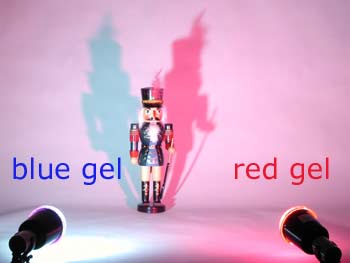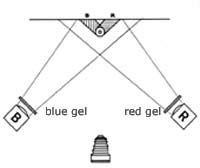My first stock shot request in 2003 was for a photograph
of cow dung in a paddock. This will just illustrate the
fact that in photography you can expect almost everything.
Unfortunately the weather was atrocious, and all the deposits
were washed out and so the deadline passed.
This request highlights the fact that in photography
you can almost expect anything to happen. Of course as
a photographer you have to use techniques to come up with
a photograph that looks a little bit better and different
compared to the person who is not a professional photographer.
I have in mind a certain approach for this shot that will
lift it above the realm of a "shit shot". We
will wait for some drier weather and a good cows meal.
Talking about techniques, what about changing the shape
of your aperture, or diaphragm, to assist you compositional
/ designing efforts?
You have probably already noticed when you take night
shots off streetlights that the appearance of the actual
light source changes on film depending on the aperture
you have used to take that photograph. A wide-open aperture
of a streetlight at night will provide a round impression
of the light itself, probably slightly diffused towards
the outer edges. If you have taken the same photograph
at an aperture of F8, or F11, or F16, you will notice,
as the aperture progressively gets smaller the actual
light source will be depicted more as a star shaped object.
Not all apertures are created equal and depending on the
construction of your aperture you will get different "star"
shaped images of the actual light source.
This notion set me on the track of constructing aperture
shapes to place behind my lens in the view camera. While
I would shoot at a wide-open aperture, using the total
glass surface of the lens, I would control the amount
of light with my own designed shaped aperture.
My light meter that measures the light on the film plane
inside the camera will give me the shutter speed to take
photograph with. I suggest that if you don't use it inside
your view camera place it in front of your medium format
camera, or your 35 SLR camera will do too.
These shaped apertures that you can make yourself will
illustrate their effect best when you use it in photography
on highly reflective surfaces, like glass for example.
In those cases you will see a reproduction of your shaped
aperture reflected on the highly reflective surfaces of
the glass. Of course if you are very experimental you
may find different effects possible, nothing beats thinking
outside the square. Of course this idea is not new, I
do not think anything in photography is new, only the
way we do it might be new... oh how hard it is to be innovative...

Like the Imagon lens is a specialist portrait lens. As
an aperture it uses a disk, you can choose between one
of five disks. Each disk consists of concentric rings
of holes of various sizes or numbers. I think this lens
was around in the late 1800's. See illustration sample
on far right. So what is new pussycats? (Sorry - Tom Jones
played in the studio...)
Apertures are normally used to increase the depth of field;
here is another way of playing with the apertures without
using (smaller) apertures.
When you want to extend the depth of field with your view
camera this technique is something so simple and effective
if the set-up allows it... imagine you've got a setup compromising
of a foreground, middle ground, and background. The whole
setup is too big, or better said too deep, to get it all-sharp
with your desired aperture opening. If you can light the
foreground and possibly the middle ground with your lights,
excluding the background, focus on the middle ground and
use your chosen aperture. This will provide you with a sharp
image of your lit area.
Make your first exposure, this will only show foreground
and middle ground. Now refocus, focus on the middle of your
background. Place your lights only on the background only
and exclude any lights only area that you have already photographed
on your first exposure. Make your second exposure on the
same transparency of the background.
This method has a problem. When you refocus on the background
the image scale changes. The foreground might appear slightly
blurred against the background. You cannot predict exactly
how this will look on your final transparency, however the
effect is not that destructive. In some cases this slight
blur a can look very natural and create even more feeling
of depth. You have to experiment with this technique and
find out with what focal length lens and type of setup this
technique will work best. Normally I like to change any
so-called negative aspects, like the effect described above,
into something positive. Perhaps with some creative backlighting
and color lights you may be able to turn this technique
into more than just the extension of depth of field. I am
interested to see any images created this way, anyway have
fun with your view camera. You can e-mail me at hotshot@ihug.co.nz.
When I mentioned color lights, you can have some fun with
two spot lights, one with a blue, and one with a red gel
over it. When you photograph a product, place one blue spot
light on the left of the product, and one red on the opposite
side.

The red spot light illuminates the product in a red from
the right and leaves a black shadow on the left-hand side
of the product.
The blue spot light on the left can be turned on the product,
and both colours, the red and blue will mix on top of the
product, creating a magenta color.

The black shadow that was created by the red spot lights
only will be blue, and the shadow created by the the blue
spot light on the right-hand side of the product will be
red. Nothing new you may say, as I said before there is
nothing new in photography, only the way we apply what we
know.

Perhaps any of the above ideas could be useful
to you. Try to go one step further, experiment?
Made this year shape up for you in a playful concoction
of light and dark shapes, may it be colourful, emotional
and rewarding. Any direct feedback to hotshot@ihug.co.nz.
Viewing you next time, cheers
Robert A F van de Voort, 2003
|










